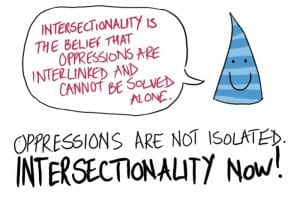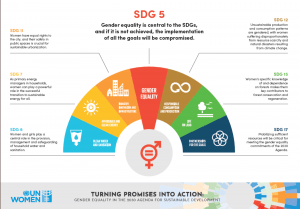Intersectionality is meant to be inclusive. Intersectionality in feminism means that feminist principles are not just for one kind of woman – they are for every person. Robby Soave, author of “Intersectionality 101,” offers a broad definition. In that piece, he wrote, “What began at the intersection of race and sex now includes economic class, gender identity (the gender category to which a person feels attachment, which may be different from the person’s biological sex), gender expression (the way a person looks and behaves), sexual orientation, immigration status, disability status, age, religious belief (though certain believers—such as Muslims—are perceived as more oppressed than others), and size (whether you are overweight or not).”
Intersectionality is important in feminism because it recognizes that there are many things people can be oppressed over, not just gender. Equality needs to be fighting for everybody, and fighting against oppression of all kinds. Intersectionality is thus related to ecofeminism. If ecofeminists are fighting against the oppression of the earth, and intersectionalist feminists are fighting against oppression of any kind, then they are easily on the same side.
In her piece “The Ecology of Feminist and the Feminism of Ecology,” Ynestra King writes, “Life on earth is an interconnected web, not a hierarchy.” This represents the blending of all forms of life on earth – not just nature, not just humans, but every living thing. King goes on to say, “A healthy, balanced ecosystem, including human and nonhuman inhabitants, must maintain diversity.” This is true for both intersectionalism and ecofeminism. All different forms of life (such as different races of humans, or different plants) have privilege and oppression throughout life.
The meshing of intersectionality and ecofeminism relate back to a topic we’ve talked about before – being vegan. If all living creatures are considered equal, and we are trying to not oppress any living thing in order to have equality all over the earth, then humans should definitely not be killing and eating animals. Greta Gaard writes about it in her piece “Eco-feminism on the Wing: Perspectives on Human Animal Relationships.” She writes, “feminists who politicize their care for animals see a specific linkage between sexism and speciesism, between the oppression of women and the oppression of animals.” If we are trying to not include living creatures in any form of opression, this trickles down to the earth and animals.
Works Cited:
SOAVE, ROBBY. “Intersectionality 101.” Reason, vol. 51, no. 3, July 2019, p. 57. EBSCOhost, search.ebscohost.com/login.aspx?direct=true&db=f5h&AN=136518165&site=eds-live&scope=site.
This is an article written by a college law professor. It cites all of it’s sources and was published in a feminist magazine.


